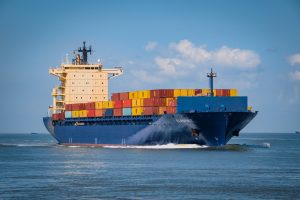Weak links in the supply chain
Shipping products from one side of the world to the other, just-in-time, at a predictable cost, is no longer a given, says Mike Rigby, CEO of MRA Research. Disease, war, wild weather, and the changing balance of global power have put globalisation and supply chains at continuing risk.
 Countries around the world have been trading goods long distances for more than 2,000 years, from the early days of luxury goods travelling from China into Europe along the Silk Road to merchants trading spices via East to West shipping routes. Global trade has grown inexorably and, in the 2000s, the sum of imports and exports grew to about half of world GDP.
Countries around the world have been trading goods long distances for more than 2,000 years, from the early days of luxury goods travelling from China into Europe along the Silk Road to merchants trading spices via East to West shipping routes. Global trade has grown inexorably and, in the 2000s, the sum of imports and exports grew to about half of world GDP.
But our belief in the globalised model of an interconnected, borderless world without trade barriers, bringing together the most efficient producers and delivering just-in-time products at low prices to affluent consumers has been shaken to the core. Disruption, from regional and world events, is challenging supply chains and all who depend on them. Is this the end of globalisation?
Where it began…
Globalisation was established in a more peaceful, stable world which emerged after the Berlin Wall came down. Interest rates were low, borrowing was cheap. The USSR had collapsed leaving Russia weakened and China was eager to become the world’s factory. A bipolar world of two main powers suddenly became one, and the US was dominant by default.
Manufacturing at very low cost on the other side of the world and shipping it back, dispersing the making of components to wherever it made the most financial and logistical sense became accepted wisdom.
In Europe, for example, car production fragmented with engines, parts and electrics made in several places zigzagging across the continent before coming together, just-in-time, to be assembled. With reliable supply, the need to hold so much stock in so many places was virtually eliminated, leaving the making of everything vulnerable to supply shocks. And shocks were on their way.
The virus that broke the world’s supply chain
Covid paralysed countries and their manufacturing and supply chains across the world – with China and India severely impacted. Containers lay scattered and abandoned across the globe from when Covid struck. Bottlenecks emerged at every node in the chain. Ships and trucks formed long queues to get into ports to load and offload. Canals became congested as previously even flows of trade tangled into knots, creating long delays and shortages. When demand bounced back, the cost of shipping containers spiked at ten times normal rates.
Exceptionally high demand from consumers and trades emptied shelves and fuelled panic buying, and delays in stock arriving brought factories to a standstill.
Just when global supply chains were recovering, the Ever-Given container ship ran aground blocking the Suez Canal for six days in March 2021. Some 369 ships queued to get through or past it, stranding nearly $10 billion worth of goods.
Say goodbye to our once stable world.
Then, in 2022, the invasion of Ukraine disrupted the supply and price of oil, gas and grain and distorted supply routes. Global timber supplies were also affected, as Ukraine, Russia and Belarus are all major exporters.
Aftershocks rippled around the world. China ran short of electricity and regional authorities switched off power to factories for two days a week. The West’s trade in oil and gas and financial sanctions had the unintended consequences of strengthening Russia’s economy and, arguably, it’s clout. China moved from being a largely neutral supplier to an assertive challenger, further distorting trade flows.
Illustrating the extreme fragility of the global supply chain, in March this year, a container ship crashed into a bridge in the key port of Baltimore disrupting shipping routes, causing long delays and increasing costs. Israel’s war on Gaza has incited Houthi rebel attacks in the Red Sea so now shipping routes are diverting around the Cape of Good Hope. This longer, more costly route is also putting ships back into the crosshairs of Somali pirates.
Meanwhile in the UK, we are still trying to navigate the adjustments to trading from Brexit with new border restrictions, checks, and paperwork disturbing trade flows.
What’s next?
Globalisation is in retreat, and we’re unlikely to see a return to the low interest rates, cheap money, stable era that created the conditions for 30 years of steady growth. Just in time supply models with minimal stockholding have given way to the need for resilience and business continuity, the ability to trade through disturbances and turmoil.
Climate change has also raised awareness of carbon miles, where products are made, and unnecessary journeys and waste of all kinds.
Is reshoring the answer? Bringing manufacturing back to the UK, or close by? Scaling up manufacturing output was never a problem in China, India, Taiwan, Vietnam, or the Philippines as they have the workforce, and costs and space are not prohibitive, whereas in the UK they are the challenges to overcome. We don’t have enough people (skilled or otherwise); money is more expensive; securing planning permission can be lengthy and uncertain; and accessing sufficient power and water can be barriers.
In practice, it may not be possible to change manufacturing and the supply chain overnight – and it may never be possible to fully wind it back.
But what is clear is that it’s far harder to excel in supply now than at any time in the past 30 years, when the world was more stable and predictable. Suppliers who manage through the uncertainty and turmoil to deliver a seamless service to merchants, so merchant customers can supply their customers and thrive are, without question, today’s supply chain superheroes.
This article was first published in the Builders Merchants News magazine.
